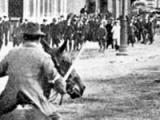Striking worker Fred Evans was badly injured in the Bay of Plenty goldmining town of Waihī. He died next day.
Waihi
Events In History
Articles
The 1912 Waihi strike
On 'Black Tuesday', 12 November 1912, in the midst of a bitter six-month strike by miners in the small New Zealand goldmining town of Waihi, striker Fred Evans was killed - one of only two fatalities in an industrial dispute in New Zealand's history. Read the full article
Page 1 - 'Black Tuesday'
On 'Black Tuesday', 12 November 1912, in the midst of a bitter six-month strike by miners in the small New Zealand goldmining town of Waihi, striker Fred Evans was killed - one of
Page 2 - Further information
Find out more about the Waihi
The 1913 Great Strike

The Great Strike of 1913 was in fact a series of strikes between mid-October 1913 and mid-January 1914. It was one of New Zealand’s most violent and disruptive industrial confrontations. Read the full article
Page 2 - Class war comes to the workers' paradise 1890-1913
History of New Zealand's employment relations,
Waihī is situated 83 km north-west of Tauranga. Waihī began as a shanty town around a store and a hotel in the 1880s. When the invention of the cyanide process made mining profitable from 1889, the town boomed. Waihī housed a thriving electronics industry for half a century after a small radio-manufacturing and repair service opened in 1932. The first television transmission in New Zealand was made at Waihī in 1954. Underground mining finished at the Martha mine in 1952. However, rising gold prices and new, more economic mining methods rekindled interest in gold mining in the 1980s. The Martha mine re-opened in 1987, this time as an open pit mine.
Meaning of place name
Wai: water; hī: to gush forth. The name came from Hawaiki.


















